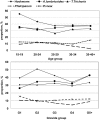Complex Interactions between soil-transmitted helminths and malaria in pregnant women on the Thai-Burmese border
- PMID: 21103367
- PMCID: PMC2982827
- DOI: 10.1371/journal.pntd.0000887
Complex Interactions between soil-transmitted helminths and malaria in pregnant women on the Thai-Burmese border
Abstract
Background: Deworming is recommended by the WHO in girls and pregnant and lactating women to reduce anaemia in areas where hookworm and anaemia are common. There is conflicting evidence on the harm and the benefits of intestinal geohelminth infections on the incidence and severity of malaria, and consequently on the risks and benefits of deworming in malaria affected populations. We examined the association between geohelminths and malaria in pregnancy on the Thai-Burmese border.
Methodology: Routine antenatal care (ANC) included active detection of malaria (weekly blood smear) and anaemia (second weekly haematocrit) and systematic reporting of birth outcomes. In 1996 stool samples were collected in cross sectional surveys from women attending the ANCs. This was repeated in 2007 when malaria incidence had reduced considerably. The relationship between geohelminth infection and the progress and outcome of pregnancy was assessed.
Principal findings: Stool sample examination (339 in 1996, 490 in 2007) detected a high prevalence of geohelminths 70% (578/829), including hookworm (42.8% (355)), A. lumbricoides (34.4% (285)) and T.trichuria (31.4% (250)) alone or in combination. A lower proportion of women (829) had mild (21.8% (181)) or severe (0.2% (2)) anaemia, or malaria 22.4% (186) (P.vivax monoinfection 53.3% (101/186)). A. lumbricoides infection was associated with a significantly decreased risk of malaria (any species) (AOR: 0.43, 95% CI: 0.23-0.84) and P.vivax malaria (AOR: 0.29, 95% CI: 0.11-0.79) whereas hookworm infection was associated with an increased risk of malaria (any species) (AOR: 1.66, 95% CI: 1.06-2.60) and anaemia (AOR: 2.41, 95% CI: 1.18-4.93). Hookworm was also associated with low birth weight (AOR: 1.81, 95% CI: 1.02-3.23).
Conclusion/significance: A. lumbricoides and hookworm appear to have contrary associations with malaria in pregnancy.
Conflict of interest statement
The authors have declared that no competing interests exist.
Figures



Similar articles
-
Burden of soil-transmitted helminth infection in pregnant refugees and migrants on the Thailand-Myanmar border: Results from a retrospective cohort.PLoS Negl Trop Dis. 2021 Mar 1;15(3):e0009219. doi: 10.1371/journal.pntd.0009219. eCollection 2021 Mar. PLoS Negl Trop Dis. 2021. PMID: 33647061 Free PMC article.
-
Intestinal helminthic infection and anemia among pregnant women attending ante-natal care (ANC) in East Wollega, Oromia, Ethiopia.BMC Res Notes. 2017 Sep 5;10(1):440. doi: 10.1186/s13104-017-2770-y. BMC Res Notes. 2017. PMID: 28870241 Free PMC article.
-
Submicroscopic malaria in pregnancy and associated adverse pregnancy events: A case-cohort study of 4,352 women on the Thailand-Myanmar border.PLoS Med. 2025 Mar 4;22(3):e1004529. doi: 10.1371/journal.pmed.1004529. eCollection 2025 Mar. PLoS Med. 2025. PMID: 40036207 Free PMC article.
-
Maternal Hookworm Infection and Its Effects on Maternal Health: A Systematic Review and Meta-Analysis.Am J Trop Med Hyg. 2020 Nov;103(5):1958-1968. doi: 10.4269/ajtmh.20-0503. Am J Trop Med Hyg. 2020. PMID: 32840198 Free PMC article.
-
Epidemiology of malaria and helminth interaction: a review from 2001 to 2011.Curr Opin HIV AIDS. 2012 May;7(3):221-4. doi: 10.1097/COH.0b013e3283524d90. Curr Opin HIV AIDS. 2012. PMID: 22418449 Review.
Cited by
-
Immunomodulation in Plasmodium falciparum malaria: experiments in nature and their conflicting implications for potential therapeutic agents.Expert Rev Anti Infect Ther. 2012 Nov;10(11):1343-56. doi: 10.1586/eri.12.118. Expert Rev Anti Infect Ther. 2012. PMID: 23241191 Free PMC article. Review.
-
Anaemia and associated risk factors among pregnant women in Gilgel Gibe dam area, Southwest Ethiopia.Parasit Vectors. 2012 Dec 17;5:296. doi: 10.1186/1756-3305-5-296. Parasit Vectors. 2012. PMID: 23244514 Free PMC article.
-
Evaluation and Acceptability of a Simplified Test of Visual Function at Birth in a Limited-Resource Setting.PLoS One. 2016 Jun 14;11(6):e0157087. doi: 10.1371/journal.pone.0157087. eCollection 2016. PLoS One. 2016. PMID: 27300137 Free PMC article.
-
Improved pregnancy outcome in refugees and migrants despite low literacy on the Thai-Burmese border: results of three cross-sectional surveys.BMC Pregnancy Childbirth. 2011 Jun 17;11:45. doi: 10.1186/1471-2393-11-45. BMC Pregnancy Childbirth. 2011. PMID: 21679475 Free PMC article.
-
Burden of intestinal parasitic infections and associated factors among pregnant women in East Africa: a systematic review and meta-analysis.Matern Health Neonatol Perinatol. 2023 Apr 6;9(1):5. doi: 10.1186/s40748-023-00150-8. Matern Health Neonatol Perinatol. 2023. PMID: 37020236 Free PMC article. Review.
References
-
- WHO. WHO report of an informal consultation on hookworm infection and anemia in girls and women. 1996. WHO/CTD/SIP/96.1. WHO Geneva.
-
- Allen HE, Crompton DW, de Silva N, LoVerde PT, Olds GR. New policies for using anthelmintics in high risk groups. Trends Parasitol. 2002;18:381–382. - PubMed
-
- Savioli L, Crompton DW, Neira M. Use of anthelminthic drugs during pregnancy. Am J Obstet Gynecol. 2003;188:5–6. - PubMed
-
- Abel R, Rajaratnam J, Kalaimani A, Kirubakaran S. Can iron status be improved in each of the three trimesters? A community-based study. Eurupean Journal Clinical Nutrition. 2000;54:490–493. - PubMed
-
- Acs N, Banhidy F, Puho E, Czeizel AE. Population-based case-control study of mebendazole in pregnant women for birth outcomes. Congenit Anom. 2005;45:85–88. - PubMed
Publication types
MeSH terms
Substances
Grants and funding
LinkOut - more resources
Full Text Sources
Medical

